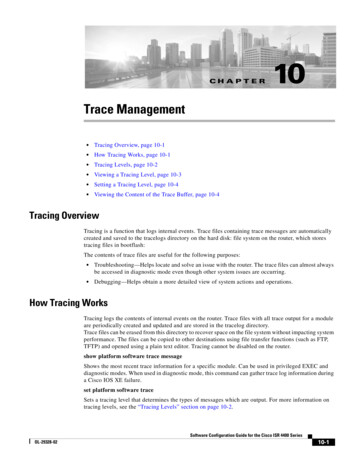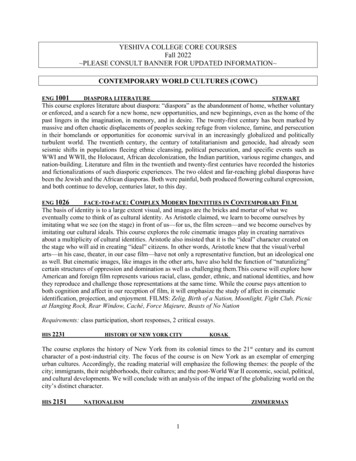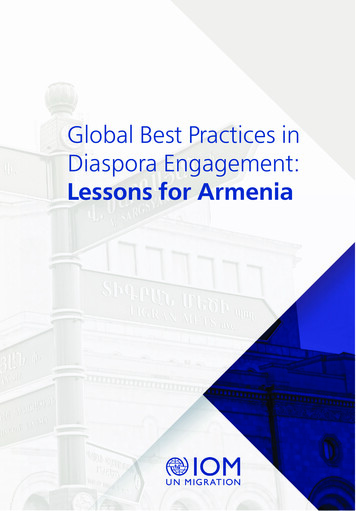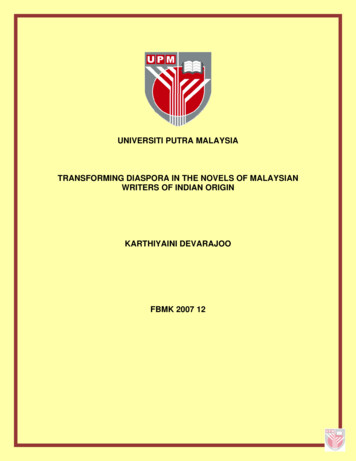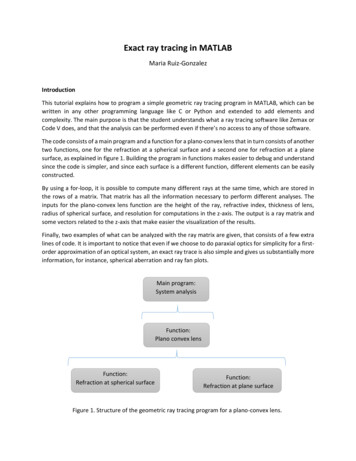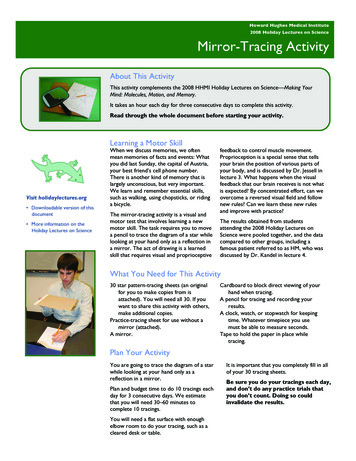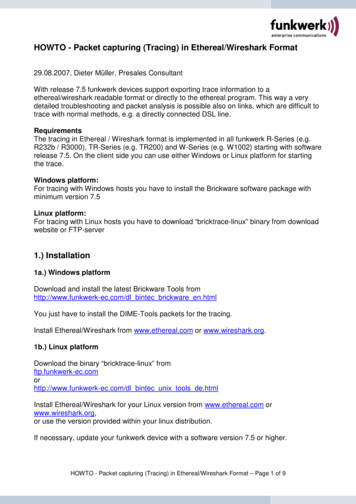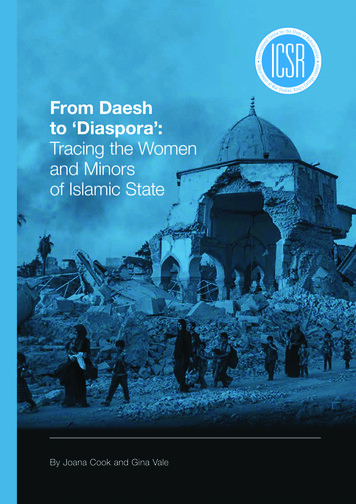
Transcription
From Daeshto ‘Diaspora’:Tracing the Womenand Minorsof Islamic StateBy Joana Cook and Gina Vale
ACKNOWLEDGEMENTSThe authors would like to thankJillian Hunchak for her extensiveresearch assistance, the fellowsat ICSR for assisting in foreignlanguage searches, and CharlieWinter for his review and feedback.CONTACT DETAILSFor questions, queries and additional copiesof this report, please contact:ICSRKing’s College LondonStrandLondon WC2R 2LSUnited KingdomT. 44 20 7848 2065E. mail@icsr.infoTwitter: @icsr centreLike all other ICSR publications, this reportcan be downloaded free of charge from theICSR website at www.icsr.info. ICSR 2018Cover picture by Tasnim Newsunder CC BY-SA 4.0
From Daesh to ‘Diaspora’: Tracing the Women and Minors of Islamic StateTable of contentsExecutive summary31 Introduction72 Dataset and methodologyDatasetDefinitions1111133 IS affiliates in the ‘caliphate’Women affiliated with IS: A global pictureBox 1 Tajikistan: Identifying and responding toIS affiliates and returneesMinors affiliated with IS: A global pictureWomen and minors prevented from travellingBox 2 The other destinations:Libya, Afghanistan, and the Philippines21224 IS affiliates after the fall of the ‘caliphate’‘The unknowns’: The challenges in accountingfor IS affiliates in Iraq and SyriaThe physical fall of the ‘caliphate’ and missing IS affiliatesFemale affiliates: Where are they now?Minor affiliates: Where are they now?Women as potential security threatsMinors as potential security threats414144465053565 Conclusion: What next for IS women and minors?Implications for policy and practice59252834361
From Daesh to ‘Diaspora’: Tracing the Women and Minors of Islamic StateTable of graphicsFigure 1 Total IS affiliates in Iraq and Syria4Figure 2 Total IS returnees to countries of departure4Figure 3 41,490 IS affiliates in Iraq and Syria14Figure 4 7,366 IS returnees from Iraq and Syria15Figure 5 Male, female and minor affiliates and returnees:A global snapshot16Figure 6 Total IS affiliates in Iraq and Syria21Figure 7 IS affiliates returned to country of departure41Figure 8 Proportion of women and minors returnedto country of departure462
Executive summaryIslamic State (IS) affiliates in Iraq and Syria 41,490 international citizens from 80 countries became affiliatedwith IS in Iraq and Syria. In the first global dataset of its scope and detail, up to 4,761(13%) of these were recorded to be women, and 4,640 (12%) ofthese minors. Eastern Asia saw the highest proportion of recorded IS-affiliatedwomen and minors at up to 70%, followed by Eastern Europe (44%);Western Europe (42%); the Americas, Australia and New Zealand(36%); Central Asia (30%); South-Eastern Asia (35%); Southern Asia(27%); Middle East and North Africa (MENA, 8%); and sub-SaharanAfrica ( 1%). Yet, a gross lack of data for many countries suggests there aresignificant gaps in real figures for women and minors globally. These gaps in data are particularly concentrated in the MENAregion which had the highest number of IS affiliates in Syria andIraq – 18,852. The number of recorded infants born inside the IS’ ‘caliphate’to international parents – at least 730 – has also led to anunderestimation of minors that must now be accounted for asforeign returnees.IS affiliates and status after the fall ofthe ‘caliphate’ This report is the first to map out in detail the diverse trajectoriesof IS foreign affiliates after the fall of the ‘caliphate’: from thosewho were killed in Syria and Iraq; executed by IS from within theirown ranks; detained by regional authorities; involved in detaineeexchanges; repatriated to their home nations; in third-partycountries; or whose status is simply unknown. We recorded up to 7,366 persons have now returned to their homecountries (20%), or appear to be in repatriation processes to do so. Only 256 (4%) of total returnees are recorded as women,accounting for up to 5% of the women who travelled to Syriaand Iraq. Up to 1,180 (17%) of total returnees are recorded as minors,accounting for up to 25% of minors who travelled to, or were bornin, Iraq and Syria.3
From Daesh to ‘Diaspora’: Tracing the Women and Minors of Islamic StateFigure 1 Total IS affiliates in Iraq and Syria41,49075%13%12%Figure 2 Total IS returnees to countries of departure79%7,3664%17%4
From Daesh to ‘Diaspora’: Tracing the Women and Minors of Islamic State South-Eastern Asia saw the highest proportion of female andminor returnees at up to 59%, followed by Western Europe (55%);Central Asia (48%); Sub-Saharan Africa (33%); Eastern Europe(18%); Americas, Australia New Zealand (8%); Southern Asia ( 1%);and MENA ( 1%). There were no returnees accounted for inEastern Asia. However, significant discrepancies in accounting for foreigncitizens in Iraq and Syria – including those described above –rarely distinguish between men and women, adults and minors,making is particularly problematic to fully assess the currentstatus of these distinct populations.Concerns about women and minorsgoing forward Women and minors are poised to play a significant role incarrying forward the ideology and legacy of IS after the physicalfall of its ‘caliphate’ in late 2017. Much attention has rightfully focused on Iraq and Syria, but Libya,Afghanistan and the Philippines have also proven notable countriesfor women and minors in IS and remain under-examined. Women and minors affiliated with and inspired by IS have alreadydemonstrated their prominence as security threats, with numerousfoiled and successful attacks plotted and carried out globally. There is a risk that many IS orphans will become stateless and fallthrough the cracks of repatriation and rehabilitation efforts. Women and minors detained in Iraq and Syria require specificattention including their access to fair trial, and potential toradicalise while detained.Best practice Women and minors must be considered as distinct and complexcategories, each with varying levels of agency. Do not referencethem in singular categories (‘women and children’, families,’ andso forth). Minors in particular require nuanced consideration.This report suggests categorising them in line with theirmotivations and proscribed roles within IS, as infants (0 – 4 years);children (5 – 14 years) and teenagers (15 – 17 years). Delineate all data of persons affiliated with terror and extremistgroups by age and gender. Ensure considerations particular to women and minorsare integrated in all efforts to respond to and counter violentextremist organisations.5
From Daesh to ‘Diaspora’: Tracing the Women and Minors of Islamic State6
From Daesh to ‘Diaspora’: Tracing the Women and Minors of Islamic State1 IntroductionThe self-proclaimed Islamic State (IS)1 has been described as ahybrid terrorist organisation and conventional army,2 a religious,millenarian group,3 an insurgency,4 and a pseudo-state,5amongst others. It produced and disseminated propaganda at anunprecedented rate, and reached a wider global audience than anypast terrorist organisation in history. As it increasingly seized territoryand resources, at its peak in late 2014 it was believed the groupcontrolled over 100,000 km² of land and the 11 million residentstherein.6 IS and those inspired by the group have thus far carried outover 4,300 attacks across at least 29 countries, demonstrating thegroup remains a significant and shared global concern.7Perhaps most notable is the diversity of those who formed itsranks that distinguished it from any terror group in history – asdemonstrated in our original dataset at least 41,490 citizens from80 countries travelled to Syria and Iraq, a quarter of which werewomen and minors. These figures for affiliates peaked at 2,000per month in 2014, before receding to just 50 per month in 2016. 87,366 of these have now returned to their country of departure(see Figure 5).The collapse of IS’ so-called ‘caliphate’ (the territory held andadministered by IS between 2014 and 2017) marked a turning pointin the organisation infamous for its brutality and terror, but the futureshape and trajectory of the organisation remains unknown. Yet, thegroup’s original vision, and the meticulous and systematic mannerin which it was carried out, suggests that its goals extended beyondthe ‘state’ it had built, and considered how to carry its ideology andorganisation forward in the face of the imminent loss of territory. It hasbeen largely recognised that the physical fall of the ‘caliphate’ is onlyone step in ultimately discrediting and defeating the organisation andextinguishing its ideology. Recognised as a ‘generational struggle’that governments will be responding to for the coming decades, it isimperative to consider and assess the long-term prospects for the12345678Also referenced to as ISIL, ISIS and Daesh.Eric Schmitt, “In Battle to Defang ISIS, U.S. Targets Its Psychology”, The New York Times, 28 December gy-.htmlGraeme Wood, “What ISIS Really Wants”, The Atlantic, March 2015, 03/what-isis-really-wants/384980/Hassan Hassan, “Insurgents Again: The Islamic State’s Calculated Reversion to Attrition in the Syria-Iraq BorderRegion and Beyond”, Combatting Terrorism Centre at West Point, 10, no.11, December 2017, ria-iraq-border-region-andbeyond/Audrey Kurth Kronin, “ISIS Is Not A Terrorist Group”, Foreign Affairs, 23 February e-east/isis-not-terrorist-groupSeth G. Jones et al., Rolling Back the Islamic State, (Santa Monica: RAND Corporation, 2017), arch reports/RR1900/RR1912/RAND RR1912.pdfOnly 140 of these have occurred outside of Syria and Iraq, which have continued to face the brunt of the group’sviolence. See: “Perpetrators: (Islamic State of Iraq and the Levant (ISIL))”, Global Terrorism Database, accessed17 June 2018, https://www.start.umd.edu/; Tim Lister et al., “ISIS Goes Global: 143 Attacks in 29 CountriesHave Killed 2,043”, CNN, 12 February 2018, sis-attacksaround-the-world/index.htmlGriff Witte, Sudarsan Raghavan, and James McAuley, “Flow of Foreign Fighters Plummets as IslamicState Loses its Edge”, The Washington Post, 9 September 2016, /2016/09/09/ed3e0dda-751b-11e6-978149e5917817547
From Daesh to ‘Diaspora’: Tracing the Women and Minors of Islamic Stategroup, and provide a broad set of responses required to challenge it.9One area remains critical to this assessment – the current and futurestatus of the men, women and minors who were affiliated with thegroup in Syria and Iraq.Considerations of IS in Syria and Iraq have thus far largely focusedon the status and activities of its male members – often the keyactors in perpetrating violence on behalf of the group. Yet, this hassimultaneously appeared to neglect the status and response to thefemales and minors that were affiliated with the organisation. Thisreport discusses these three groups as ‘IS affiliates’, recognisingthe important and unique considerations these distinct categoriesaffiliated with IS require. Yet, the very knowledge base for this analysishas until now remained unclear in four particular areas.First, the global figures for how many women and minors travelledto Syria and Iraq and became affiliated with IS remain vague.Previous estimates have been limited in scope, or geographicalproximity mostly focused on Western Europe or the Balkans.10Second, the number of infants born in IS territory to foreign parentswho must now be assessed as foreign citizens in many casesremains unclear. Third, how many female and minor affiliates havenow returned to their home countries are also significantly underexamined. Fourth, the various factors that impacted all IS affiliatesand their subsequent trajectories after the fall of the ‘caliphate’ inlate 2017, and the significant discrepancies in accounting for theseindividuals, remain stark. This report aims to amend this.Surveying 80 countries whose citizens travelled to Iraq and Syria, aswell as those that were born there to foreign parents, this report hasestablished the first global dataset of its scope prioritising a focus onthe women and minors associated with IS. Based on methodologicalresearch and the compilation of official, academic and other crediblefigures from around the world, this report argues that the populationsof women and minors affiliated with IS have been significantlyunderestimated and under-analysed. It also highlights how somecountries and regions have been much stronger at compiling andpublishing gender- and age-delineated data, while others haveneglected this, leaving critical gaps in holistically understanding thegroup, and the implications for shared and coordinated responsesdeveloped to counter IS. While this report focuses on women andminors, these are discussed as two distinct and nuanced categories,each recognised as requiring specific considerations and responses(thus avoiding the problematic conflation of ‘womenandchildren’).11910118Sabrina Siddiqui, “Barack Obama Says Fights Against Isis Will be ‘Generational Struggle’”, The Guardian,6 July 2015, rack-obama-isis-generational-strugglepentagon; Lizzie Dearden, “Islamist Attacks will Threaten UK for Decades, Former Head of MI5 Warns asPolice Say Isis is Creating Terror ‘Cult’”, The Independent, 11 August 2017, 6.htmlEarly reports broadly cited include those from ICSR (2013) and the Soufan Group (2015), which did not citewomen and minors though three subsequent reports did begin to expand on these two categories to anextent: Vlado Azinović, and Edina Bećirević, A Waiting Game: Assessing and Responding to the Threat fromReturning Foreign Fighters, (Sarajevo: Regional Cooperation Council, 2017), ign-fighters-in-the-westernbalkans; Bibi van Ginkel, and Eva Entenmann, eds., The Foreign Fighters Phenomenon in the European Union:Profiles, Threats & Policies, (The Hague: International Centre for Counter-Terrorism, 2016), port Foreign-Fighters-Phenomenon-in-the-EU 1-April-2016 includingAnnexesLinks.pdf; and Richard Barrett, Beyond the Caliphate: Foreign Fighters and the Threat of Returnees,(New York: The Soufan Center, 2017), Enloe, Cynthia. Bananas, Beaches and Bases: Making Feminist Sense of International Politics. University ofCalifornia Press, 1993
From Daesh to ‘Diaspora’: Tracing the Women and Minors of Islamic StateIn terms of the long-term physical and ideological survival ofIS, and the globally shared potential security implications thesehold, this report argues these two populations hold growingimportance and demand increased attention. This report is thuscomplementary to those who have traced the broader evolutionof IS in Syria and Iraq: as male members have been increasinglykilled in theatre, what impact or significance may this hold forthe role and status of its female and minor members? It may alsoencourage further inquiry into the types of affiliates most commonin certain countries – whether men, women or minors. Wherelarge numbers of women and minors were recorded, does thissuggest, for example, that more family units travelled? Where moremen travelled were there gender-based motivations that could bedetermined? Where information is currently publicly unavailable,as seen in the MENA region, and countries such as Uzbekistan,does this mean that gender and minor-conscious considerationsare more likely to be neglected in responses to the group? Suchgaps may also have explicit implications for tracing movements ofpopulations who have now left Syria and Iraq.This report also establishes a strong base by which to encouragemore gender- and minor-conscious analysis in all efforts tounderstand and counter IS and its underlying ideology. From thepresent government responses to dealing with returnees and thepunitive, rehabilitation, reintegration, de-radicalisation and otherconsiderations inherent in these, to the forward looking counterradicalisation and more indirect efforts such as countering violentextremism (CVE), stabilisation, or human security considerations,there has never been a more pertinent time to recognise andintegrate gender and minor considerations into all streams of effortto counter IS and prevent its re-emergence in the future.The body of this report is divided into four chapters. Chapter 2presents our methodology, and definitions. Most importantly itincludes the full dataset for 80 nations of those who have travelledto Iraq and Syria and became affiliated with IS, and those whohave now returned. Women and minors are highlighted distinctlyin these, and the 80 countries are divided into nine regions.Chapter 3 analyses these figures for women and minors whotravelled to Iraq and Syria, and considers their diverse motivationsand roles within IS. It also highlights those that were preventedfrom travel, noting these as a distinct group which also requiresattention. Chapter 3 also includes brief analysis of thosethat travelled to other conflict zones: Libya, Afghanistan andthe Philippines.Chapter 4 focuses on the status of men, women and minorsafter the fall of the ‘caliphate’ in late 2017. Analysed extensivelyfor the first time, it highlights a number of key factors we label as‘the unknowns’ – the factors that prove particularly problematicfor accounting for foreign men, women and minors in IS today.These include a discussion of problems in accounting for thebattlefield deaths of IS affiliates by the Global Coalition AgainstDaesh killed in Syria and Iraq; those executed by IS from withintheir own ranks; detained by regional authorities; involvedin detainee exchanges; repatriated to their home nations; inthird-party countries; or those whose status is simply unknown.These unknowns provide a backdrop for subsequently tracing9
From Daesh to ‘Diaspora’: Tracing the Women and Minors of Islamic Statewomen and minors in IS now as returnees; as those who remain intheatre; those who are detained; and those whose status is simplyunknown. Finally it considers both women and minors as potentialsecurity threats going forward.The concluding chapter focuses on implications for policy andpractice and reiterates the importance of considering women andminors in all research, data and responses related to terror andextremist groups. It also explicitly highlights the multi-sector benefitsof considering women and minors in all efforts against IS.10
From Daesh to ‘Diaspora’: Tracing the Women and Minors of Islamic State2 Dataset and methodologyThis dataset is both expansive and limited in what it is able to tellus in relation to IS affiliates who travelled to, and in some casereturned from, Syria and Iraq. Most imperatively, it offers a globalpicture of the diversity of those who travelled in support of IS in terms ofgeographical footprint, gender profile, and age demographics (includinginfants born in theatre). It also brings to light many crucial pieces ofthis puzzle including the current status of returnees, those detainedin Iraq and Syria, those killed on the battlefield, and those who simplyremain unaccounted for. It thus assists in better understanding how theformation, membership and status of IS has evolved, and where focusshould extend to in current assessments and government responses.This dataset is unable to offer new insights into the very personal andindividualised motivations that drove single persons, friends or entirefamily units to affiliate themselves with IS. This level of qualitative detailis beyond the scope of figures alone. However, this report has alsodrawn on academic literature, government reports and real-worldexamples to highlight what these figures may suggest in practice.Regional and national-level data can also indicate which countries andregions saw higher numbers of men, women or minors travel, thusdemonstrating the need for gender and age-specific analysis into thefactors surrounding these.DatasetThe authors drew information from an extensive range of sources tocompile this original dataset. Official government sources and figureswere deemed the most reliable, and of the 283 sources ultimately utilised,the majority of the data is drawn from these. However, in the cases wherethis was not available, figures were taken from academic or institutionalpublications and media reports deemed credible. In cases where onlyindividual cases were found, these were compiled and highlightedas individual cases recorded (ICR). ICRs are not comprehensive, andoffer little numerical value to the dataset, but they do indicate thatindeed women and minors were departing from, or returning to, thesecountries, prompting the need for further examination. The data isdrawn from figures reported between April 2013 and June 2018 in linewith the formal announcement of ISIL by Abu Bakr al Baghdadi onApril 8, 2013, and the most updated government figures available.This search included utilising two sets of fixed search terms acrossthree search engines. The first search was conducted to identify figuresfor those who had travelled to join (and infants born into) IS in Syriaand Iraq. A second search was subsequently conducted to identifyreturnees to their countries of origin. The three search engines utilisedwere: Lexis Nexis, BBC Monitoring and Google.The authors reviewed approximately 90,500 individual items.120 countries were first searched on Lexis Nexis with up to1,000 individual items reviewed per country (though the numberof results per country were considerably less in the 30 countries11
From Daesh to ‘Diaspora’: Tracing the Women and Minors of Islamic Statewhich were subsequently excluded from the dataset, and from thosecountries which were included in our dataset but where women werenot acknowledged in often very small figures such as Cambodia,Madagascar and Senegal). It was then determined that 80 countrieswere relevant to be included in the dataset as they had confirmedsuccessful cases of persons traveling to Syria and Iraq. Countries wereexcluded where the only persons identified were those that attemptedto travel but were intercepted before they arrived in theatre in Syria andIraq. These 80 countries were each then searched in BBC monitoringwhich produced between 0 and 48 results per country. Finally, a manualGoogle search was conducted where a minimum of 50 results werereviewed per country.Each of these brought with it a particular research advantage includingbeing able to access local media in each country, and government andresearch centre reports. While the majority of searches were conductedin English, additional searches were conducted in Russian, Arabic,French, Turkish and Italian where information was otherwise sparse.No method or dataset is perfect, and the authors acknowledge a numberof limitations faced while researching this report. Most notably, therewere many countries where data was simply unavailable, or specificallylacked distinct figures for women and minors. It was also not evident ifaffiliates who held dual citizenship were counted twice in national figures(both country of birth and of departure). It is also acknowledged thatsome countries simply did not have the capacity to adequately recordall figures, border movement and movement of citizens, and that gaps inknowledge may remain even at the national level. There were also rarecases of parents going to bring their children home, but it was not clearhow these were accounted for in national figures.There was particular difficulty when countries did not distinguish betweencategories of minors, women and men. Examples of these includedfigures that were labelled as ‘family’, ‘women and children’, ‘returnees’or ‘killed’, where the researchers were unable to distinguish the specificgender or category of person. For the sake of simplicity in the dataset,when women and minors have been grouped together in figures a meanaverage was taken (resulting in half for minors and half for women) toreflect best practice recognised in quantitative methods. This was donein three countries: China (‘families’), Indonesia (‘women and children’)and Russia (‘women and children’). These are distinguished by the tildesymbol ( ) to indicate these figures are a mean average. It was also notclear in all countries that female and minor IS affiliates were counted ingovernment ‘foreign fighter’ figures. For example, the Netherlands did notinclude children under nine years old in returnee estimates.12The dataset excluded several categories of persons. In cases wherecountries had nationals travelling to multiple conflict zones over theperiod of analysis (notably Libya and Afghanistan), the dataset recordedfigures only for those who travelled to Iraq and Syria. Figures for Syrianand Iraqi nationals are also excluded, on account of sparsity of localdata and the inability to clearly distinguish voluntary IS recruits fromcoerced civilians.13 The authors also focused on persons that joined121312General Intelligence and Security Service, “Focus on Returnees”, Dutch Ministry of the Interior and KingdomRelations, 15 February 2017, 2, 2017/02/15/publication-focuson-returneesIn her research on state-building terrorist groups, Mara Revkin explores the discrepancies and necessaryconsiderations for classification of civilians living under IS rule. See Mara R. Revkin, “When Terrorists Govern:Protecting Civilians in Conflicts with State-Building Armed Groups”, Harvard National Security Journal 9 (2018):138, http://harvardnsj.org/wp-content/uploads/2018/01/3 Revkin WhenTerroristsGovern-2.pdf
From Daesh to ‘Diaspora’: Tracing the Women and Minors of Islamic StateIS and excluded figures for those that joined other jihadist groups suchas Jabhat al-Nusra (JaN), and later Jahbat Fateh al-Sham and Tahriral-Sham (HTS) when possible, though this distinction was not alwaysavailable. While the authors recognise the presence of foreign affiliatesin these diverse groups, this analysis focuses on IS on account oftheir explicit calls for all persons (women, minors, and men) to join andcontribute to the organisation. This was also reflected in a significantproportion of government sources and official media quoting IS asthe specific organisation their citizens joined, and viewed as the mostsalient security threat. When distinct figures for groups were available,the authors utilised only those related to IS. Where foreign affiliates inall conflict zones were undistinguished in government figures this isacknowledged in the reference.‘Foreign fighters’ that travelled in support of counter-IS operationswere also omitted, such as those who supported the Kurdish People’sProtection Units (YPG), Kurdish Women’s Protection Units (YPJ),and Syrian Democratic Forces (SDF). Similarly, the dataset omits‘foreign fighters’ that travelled to support pro-Assad forces, includingstate-sanctioned forces from Iran, Russia and Lebanon in particular.The authors separately compiled cases where women or minors hadattempted travel but were prevented from doing so. These figures wereexcluded from the dataset but are discussed briefly in Chapter 3.DefinitionsIslamic State (IS) affiliates: Men who travelled to the conflict theatre ofIraq and Syria are most commonly referenced to as ‘foreign terroristfighters’, while women are often referred to as ‘migrants’.14 Minors havebeen associated in various ways, even while recognised as distinctgroups (see ‘minors’ below). For the sake of simplicity, we categoriseall foreign nationals that were born into IS, or travelled to Syria and Iraq(whether willingly or coercively) who became associated with the groupas ‘IS affiliates’.Minors: This category comprises minors as defined in each nationalcontext, such as when governments self-reported on the numberof minors who travelled. The authors worked off the assumptionthat government figures on minors included all individuals under theinternationally recognised age of legal consent (18), even if somedistinguished between youth, minors, children, toddlers and infants.This paper sub-categorises minors as infants (0 – 4 years), children(5 – 14 years), and teenagers (15 – 17 years). The number of IS affiliatesreferenced in this report who are minors also includes those who wereborn in-theatre, many of whom have a right to the citizenship of theirforeign parent(s).Returnees: Persons who successfully travelled to Iraq and Syria andbecame affiliated with IS, and who have now returned to their countryof departure. This includes infants born in IS territory and subsequentlyreturned to their parents’ country of origin. Returnee figures excludethose who had attempted travel but were interrupted. This alsoexcludes those that have travelled onwards to third-party countries,whether other conflict theatres or ‘transit countries’.14Coined in Carolyn Hoyle, Alexandra Bradford, and Ross Frenett, Becoming Mulan? Female Western Migrants toISIS, (London: Institute for Strategic Dialogue, 2015), 02/ISDJ2969 Becoming Mulan 01.15 WEB.pdf13
From Daesh to ‘Diaspora’: Tracing the Women and Minors of Islamic StateFigure 3 41,490 IS affiliates i
2 From aesh o Diaspora': Tracing the Women and Minors of Islamic State 2 Table of graphics Figure 1 Total IS affiliates in Iraq and Syria 4 Figure 2 Total IS returnees to countries of departure 4 Figure 3 41,490 IS affiliates in Iraq and Syria 14 Figure 4 7,366 IS returnees from Iraq and Syria 15 Figure 5 Male, female and minor affiliates and returnees:
